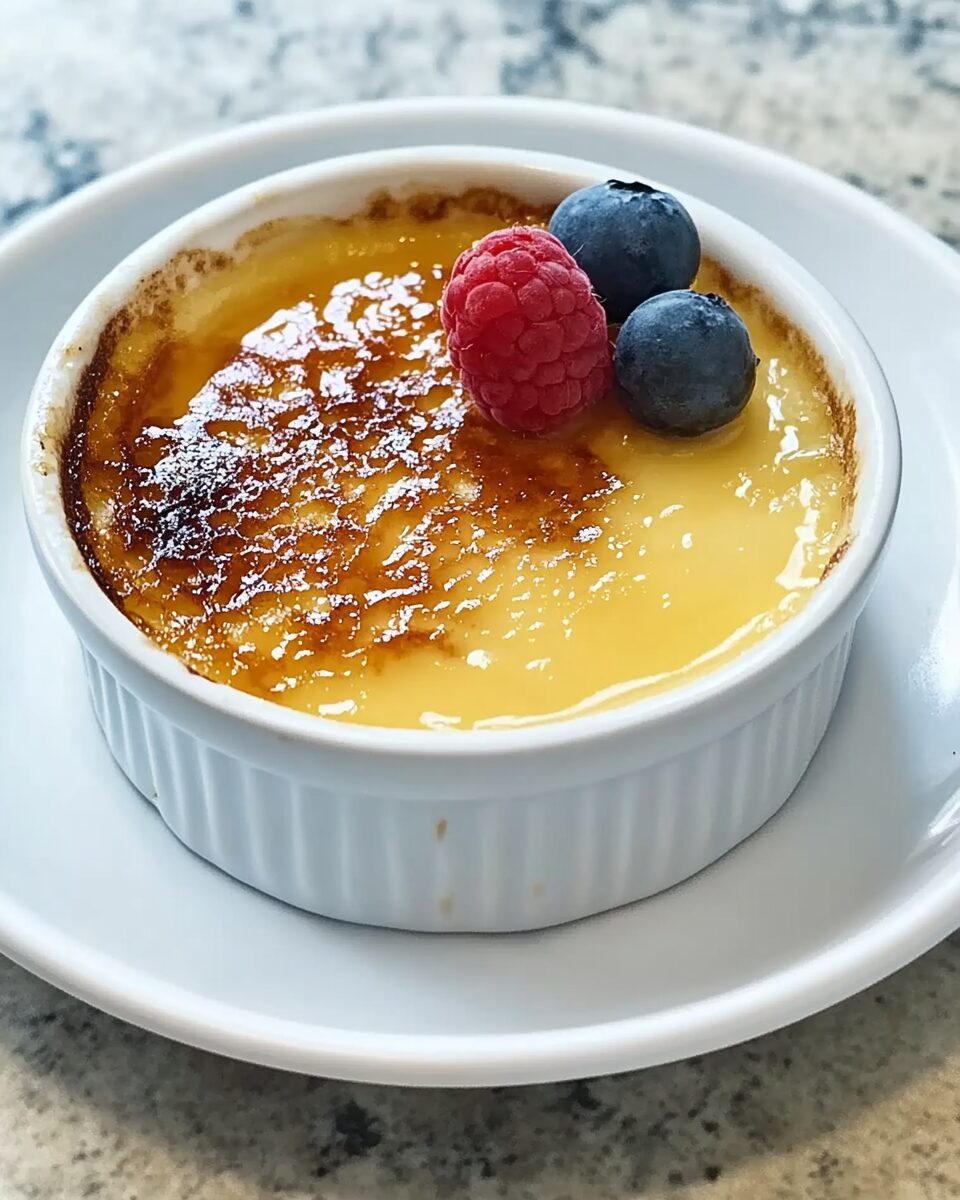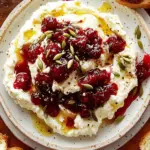The magic of Crème Brûlée lies in its contrasting textures — the silky, smooth vanilla custard base meets a crisp, caramelized sugar topping that cracks at the touch of your spoon. This timeless French dessert is surprisingly easy to make at home with just a few simple ingredients and a touch of culinary flair.
Whether you’re preparing a romantic dinner for two or aiming to impress at your next dinner party, Crème Brûlée delivers elegance and indulgence in every bite. With its creamy custard and dramatic caramel top, this dessert proves that sometimes the simplest things bring the most delight.
Full Recipe:
-
1 cup heavy cream
-
3 tablespoons white sugar (plus 2 tablespoons for topping)
-
2 large egg yolks
-
1/2 teaspoon vanilla extract
Directions:
-
Preheat the oven to 350°F (175°C).
-
In a microwave-safe bowl, whisk together the cream and 3 tablespoons of sugar until well combined. Microwave for 1–2 minutes, or until warm. Whisk again to dissolve the sugar.
-
Add egg yolks and vanilla to the mixture and whisk until smooth.
-
Pour the custard mixture into two ramekins and place them in a roasting pan.
-
Fill the roasting pan with hot water halfway up the sides of the ramekins.
-
Bake for about 50 minutes, or until the custard is just set and slightly jiggly in the center.
-
Remove ramekins from the hot water and refrigerate for at least 2 hours until chilled.
-
Just before serving, sprinkle 1 tablespoon of sugar evenly over each custard.
-
Use a kitchen torch to caramelize the sugar topping until browned and bubbly, about 30 seconds. Allow the sugar crust to harden before serving.
Prep Time: 10 minutes | Cooking Time: 50 minutes | Total Time: 3 hours (including chilling)
Kcal: ~340 kcal per serving | Servings: 2 servings
A Timeless French Dessert with Universal Appeal
Crème Brûlée is the embodiment of elegance in the world of desserts. Translating to “burnt cream,” this classic French treat has found its way into fine dining menus and home kitchens across the globe. It’s beloved for its rich, velvety custard base and the signature crack of its torched sugar crust. Simple yet sophisticated, this dessert strikes the perfect balance between creamy and crunchy, subtle and sweet.
With only a few ingredients—cream, sugar, egg yolks, and vanilla—Crème Brûlée stands as a shining example of how basic components can be elevated through technique and presentation. Whether you’re a home baker trying to impress guests or a culinary novice looking to explore classic recipes, this dessert offers a luxurious experience without requiring professional skills or specialized equipment.
The History Behind Crème Brûlée
The origins of Crème Brûlée are often debated. Some culinary historians claim the dessert first appeared in France in the 17th century, while others point to similar dishes in England and Spain. The English version, known as “burnt cream,” was mentioned in a 1691 cookbook by François Massialot, a chef who served in the court of Louis XIV. Despite these variations, the version we know today—with its smooth custard and caramelized sugar topping—is distinctly French in style and execution.
In France, the dish gained prominence in the early 20th century, eventually becoming a staple in restaurants and brasseries. Over time, chefs around the world have put their own twists on it, incorporating everything from citrus zest to flavored liqueurs, but the essential structure remains the same.
Why Crème Brûlée Is a Favorite Among Chefs
Chefs love Crème Brûlée not only for its taste but also for its adaptability and presentation value. The dessert can be made in advance, chilled, and caramelized just before serving, making it an ideal option for dinner parties or restaurant service. Its simple base can be infused with various flavors, allowing chefs to be creative without compromising the core identity of the dish.
From a technical perspective, Crème Brûlée is a fantastic example of precision cooking. The custard needs to be set just right—firm enough to hold its shape, but still tender and creamy in the mouth. Overcooking can lead to curdling, while undercooking may leave the custard too runny. Achieving the perfect texture is both an art and a science, offering a satisfying challenge for culinary professionals and enthusiasts alike.
The Science of the Perfect Custard
The success of Crème Brûlée hinges on the emulsification of egg yolks with warm cream, which results in a stable, silky custard once baked. The gentle heat from a water bath (or bain-marie) ensures even cooking, preventing the eggs from scrambling and producing a smooth consistency. Unlike puddings thickened with starch, this custard relies purely on the protein structure of the eggs.
The caramelized sugar topping not only adds a sweet, crunchy contrast but also acts as a natural barrier, preserving the delicate texture of the custard beneath. When torched properly, the sugar melts and hardens into a crisp, glass-like surface that shatters delightfully with each spoonful.
Flavor Variations and Creative Twists
Though the classic vanilla version is universally adored, Crème Brûlée offers endless opportunities for customization. Here are a few popular variations:
-
Chocolate Crème Brûlée: By adding melted dark chocolate to the cream mixture, you get a deeper, richer version perfect for chocolate lovers.
-
Espresso or Coffee-Infused: A shot of espresso or steeped coffee beans add a bitter note that beautifully balances the sweet cream.
-
Citrus Zest: Lemon, orange, or even yuzu zest introduces a bright, refreshing aroma and flavor.
-
Herbal and Floral Infusions: Lavender, rosemary, or basil can be steeped in the cream for an earthy or floral nuance.
-
Boozy Additions: A splash of Grand Marnier, Amaretto, or bourbon elevates the dessert into something truly decadent.
These additions are typically infused into the cream before it’s mixed with the eggs, allowing the flavor to permeate the custard without altering its silky texture.
Tips for Making It at Home
Making Crème Brûlée at home is easier than it may seem, but there are a few key tips to ensure the best results:
-
Use high-quality ingredients: With such a short list, each element stands out. Opt for fresh cream, real vanilla extract or beans, and organic egg yolks if possible.
-
Temper your eggs: Always whisk warm cream gradually into the yolks to avoid curdling.
-
Strain your custard: Passing the mixture through a sieve removes any lumps and ensures a smooth texture.
-
Water bath is essential: Baking the ramekins in a water bath regulates the cooking temperature and prevents cracking.
-
Chill completely: The custard needs to cool and firm up in the refrigerator for at least 2 hours—preferably overnight.
-
Torch just before serving: Caramelize the sugar topping just before bringing the ramekins to the table to preserve the crunch.
Do You Really Need a Torch?
A kitchen torch is the traditional and most effective way to caramelize the sugar on top of Crème Brûlée. It allows you to control the heat and achieve an even, golden crust without warming the custard below. However, if you don’t own a torch, you can use your oven’s broiler. Place the ramekins under high heat for 1–2 minutes, watching closely to prevent burning. While it’s a bit trickier to control, the result can still be delicious.
Serving and Presentation Tips
Crème Brûlée is often served in wide, shallow ramekins to maximize the surface area for the caramelized sugar crust. Garnish ideas include a few fresh berries, a mint sprig, or a dusting of powdered sugar around the plate’s edge. Serve with a small dessert spoon to allow for dainty bites that savor the contrast between creamy custard and crisp sugar shell.
For a truly restaurant-style presentation, consider plating with complementary elements like:
-
A smear of berry coulis
-
A quenelle of whipped cream or mascarpone
-
A thin biscotti or tuile for added crunch
Crème Brûlée vs. Similar Desserts
It’s easy to confuse Crème Brûlée with other custard-based desserts, but each has its distinct characteristics:
-
Flan (or crème caramel): Baked with caramel at the bottom of the mold, which becomes the sauce when flipped.
-
Pot de crème: A French dessert similar in texture but not topped with caramelized sugar.
-
Panna cotta: An Italian treat that uses gelatin to set cream rather than eggs.
What sets Crème Brûlée apart is its unique two-texture contrast—smooth beneath, crisp on top—which turns eating it into a sensory experience.
Conclusion: A Must-Have in Every Baker’s Repertoire
Crème Brûlée is more than just a dessert—it’s a culinary statement. With its classic French roots, luxurious texture, and dramatic caramel top, it captures both tradition and flair. The beauty of Crème Brûlée lies in its versatility: it can be dressed up for a fine-dining affair or served in a cozy setting for an indulgent treat at home.
Whether you stick with the timeless vanilla version or explore exciting flavor infusions, mastering Crème Brûlée will give you a go-to dessert that never fails to impress. With just a bit of care and technique, you’ll be rewarded with a stunning, crackling creation that delights both the palate and the eyes.






